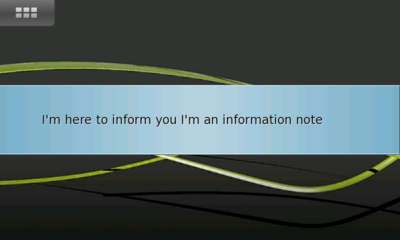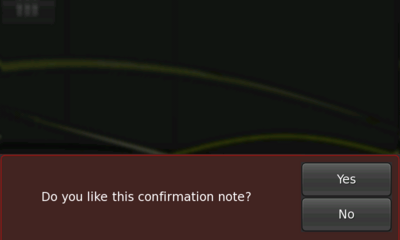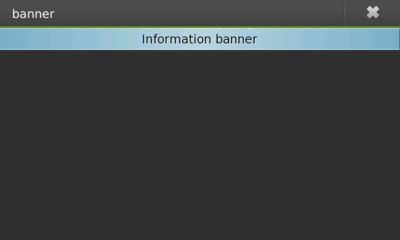Legacy Maemo 5 Documentation/Human Interface Guidelines/Notes and Banners
Contents |
[edit] Notes and Banners
Notes or Banners should be used when it is necessary to present users with application-specific information or to ask for some kind of confirmation.
Because these widgets interrupt the natural flow of most application interactions, they should be used sparingly and only when crucial to a specific function of the application.
While banners do not require any user interaction in order to be dismissed, notes always need one.
[edit] Information Notes
Information notes are modal dialogs that display information, but have no buttons -- simply pressing anywhere on the screen will make the note disappear.
Figure 3: An information note
This kind of a note should only be used when immediate attention is required (information that users must read). For example, if an application is performing an important task that requires user input in order to complete the task.
Information Notes should only be used when necessary, as there are other, less obtrusive ways to interact with users.
[edit] Confirmation Notes
Confirmation Notes are modal dialogs with two or more options available to the user. Confirmation Notes can be viewed as the Hildon equivalent to GTK's alert dialogs.
Figure 4: An confirmation note
These notes should be used when the application is about to perform a task that might lead to an unintended action like destroying data, compromising security, or requiring inordinate processing time. Unlike Information Notes, Confirmation Notes only disappear after a user's response, that is, they won't go away until the user presses one of the note's buttons.
Use Confirmation Notes in moderation and consider making their frequency user-configurable in the application's Preferences dialog (i.e., allow users to turn off features like confirming to quit the application, etc).
[edit] Note Buttons
In most cases, Confirmation Notes should only ask "Yes" or "No" questions where the text on the buttons is "Yes" and "No." Also, assure that button ordering is consistent across your application. Don't set the "Yes" button as the first button in one Confirmation Note but as the second button in other notes.
[edit] Banner
Banners are used to display information for a specified duration. This type of notification should be used to display non-critical information (that a certain task is complete, or that an application state has changed, etc.).
The period of time that a banner will stay onscreen can be adjusted. However, the duration should not be excessive, as it is an intrusive method for displaying information.
Figure 5: An banner
Banners should be distinguished from the system's own banners, that is, they should suggest to the user which application they belong to. This can be done by displaying the application's name or by making it clear in the message's text.
- This page was last modified on 12 November 2011, at 04:56.
- This page has been accessed 16,193 times.



